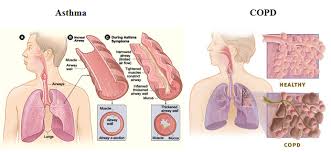Chronic respiratory conditions like asthma and chronic obstructive pulmonary disease (COPD) affect millions of people worldwide, impacting their quality of life and daily activities. While these conditions cannot be cured, they can be effectively managed through a combination of conventional treatments and complementary approaches. In this blog post, we'll explore asthma and COPD, and discuss how action plans, yoga, and herbal remedies can play a role in their management.
Understanding Asthma and COPD

Asthma
Asthma is a chronic inflammatory condition of the airways characterized by recurring episodes of breathing difficulties. Common symptoms include:
- Wheezing
- Shortness of breath
- Chest tightness
- Persistent cough, especially at night or early morning
Asthma symptoms can vary in severity and frequency, ranging from mild intermittent to severe persistent cases[16][18].
COPD
Chronic Obstructive Pulmonary Disease (COPD) is a progressive lung condition that includes emphysema and chronic bronchitis. COPD symptoms typically include:
- Persistent cough with mucus production
- Shortness of breath, especially during physical activities
- Wheezing
- Chest tightness
- Fatigue
COPD often develops over time and is primarily caused by long-term exposure to irritants like cigarette smoke or air pollution.
The Importance of Asthma Action Plans
An asthma action plan is a written document developed in collaboration with your healthcare provider to help you manage your condition effectively. Key components of an asthma action plan include:
1. Identification of asthma triggers
2. Daily medication regimen
3. Instructions for recognizing and responding to worsening symptoms
4. Emergency contact information
Asthma action plans typically use a traffic light system:
- Green Zone: Everyday management when symptoms are well-controlled
- Yellow Zone: Caution, when symptoms start to worsen
- Red Zone: Emergency situation requiring immediate medical attention
Having an asthma action plan can significantly improve asthma control, reduce hospital visits, and enhance overall quality of life.
Yoga for Respiratory Health
Yoga can be a beneficial complementary practice for managing both asthma and COPD symptoms. Here are some ways yoga can help:
1. Improved breathing techniques: Pranayama (yogic breathing exercises) can enhance lung capacity and efficiency.
2. Strengthening respiratory muscles: Certain asanas (poses) can help strengthen the muscles involved in breathing.
3. Stress reduction: Yoga's emphasis on mindfulness and relaxation can help reduce stress, a common trigger for asthma attacks.
4. Increased flexibility: Regular practice can improve overall flexibility, including in the chest and rib cage, allowing for better lung expansion.
Some beneficial yoga poses for respiratory health include:
- Setu Bandhasana (Bridge Pose)
- Ardha Matsyendrasana (Half Spinal Twist)
It's important to practice yoga under the guidance of a qualified instructor, especially if you have a respiratory condition.
Herbal Remedies for Asthma and COPD
While herbal remedies should not replace prescribed medications, some herbs have shown potential benefits for respiratory health:
1. Ginger: May help relax airway muscles and reduce inflammation.
2. Turmeric: Contains curcumin, which has anti-inflammatory properties that may help reduce airway inflammation.
3. Garlic: May have anti-inflammatory effects that could ease asthma symptoms.
4. Echinacea: Might help boost the immune system and potentially reduce the frequency of respiratory infection.
5. Licorice root: Contains compounds that may have anti-asthmatic effects and help relax bronchial tubes.
It's crucial to consult with your healthcare provider before incorporating any herbal remedies into your treatment plan, as they may interact with medications or cause side effect.
Conclusion
Managing asthma and COPD requires a comprehensive approach. While conventional treatments remain the cornerstone of management, incorporating tools like asthma action plans, yoga practices, and carefully selected herbal remedies can potentially enhance overall respiratory health and quality of life. Always work closely with your healthcare provider to develop a personalized management plan that addresses your specific needs and condition severity.
Other Link-
Boost Your Immunity with Prabhat Giloy Ghan Vati Amidst the COVID XEC Variant Threat
Understanding the HMPV Virus: Precautions and Ayurvedic Remedies
Discover Your Ayurvedic Body Type for Free: Unlock the Secrets to Holistic Wellness

